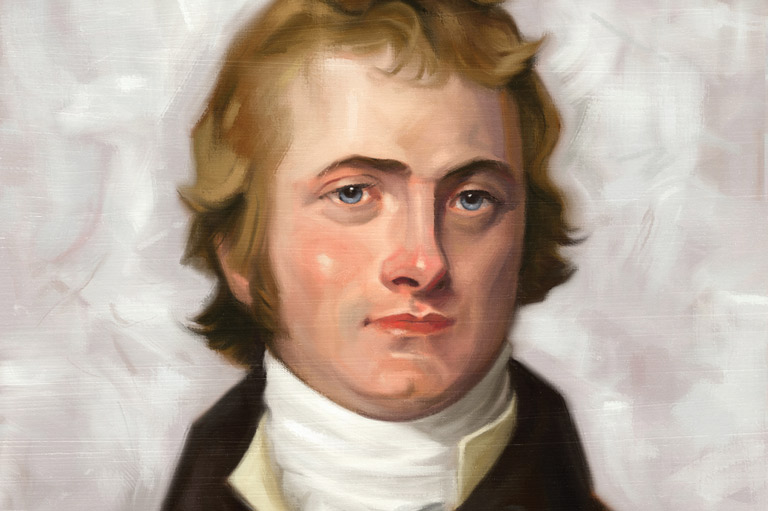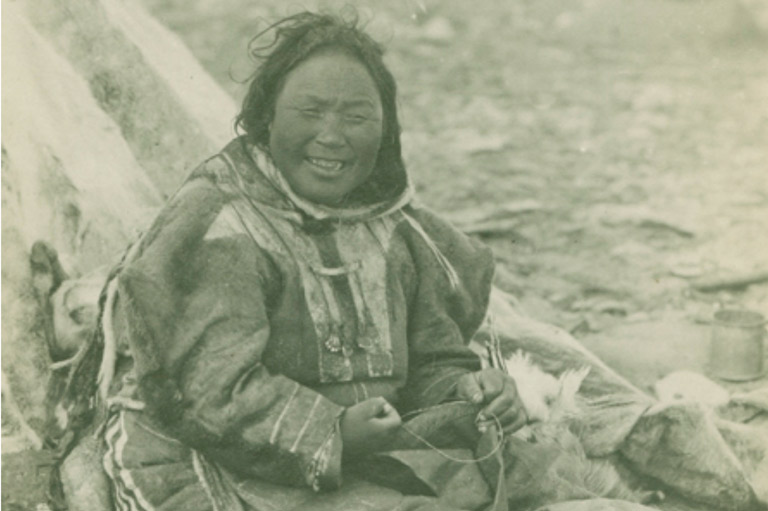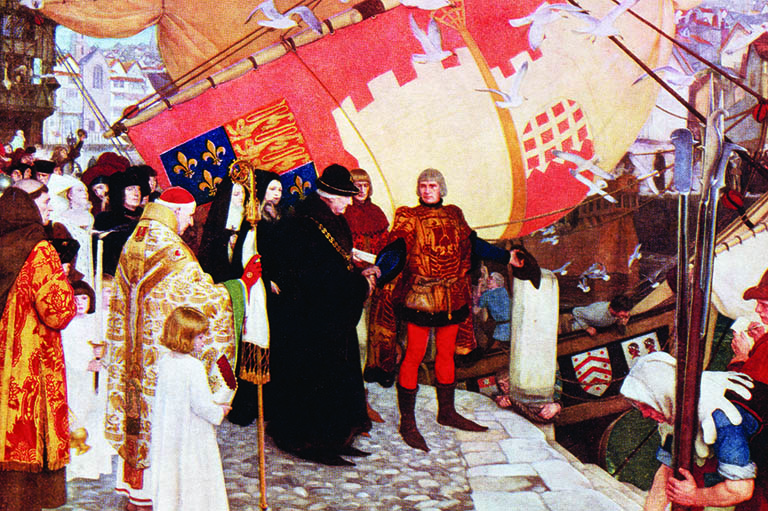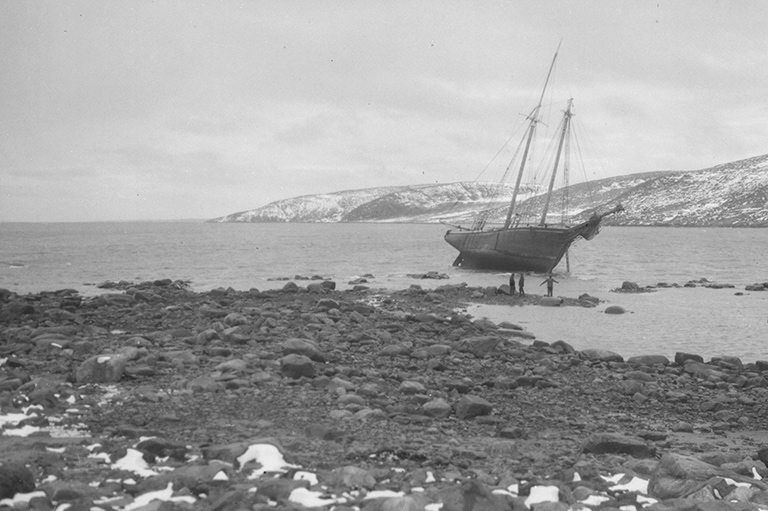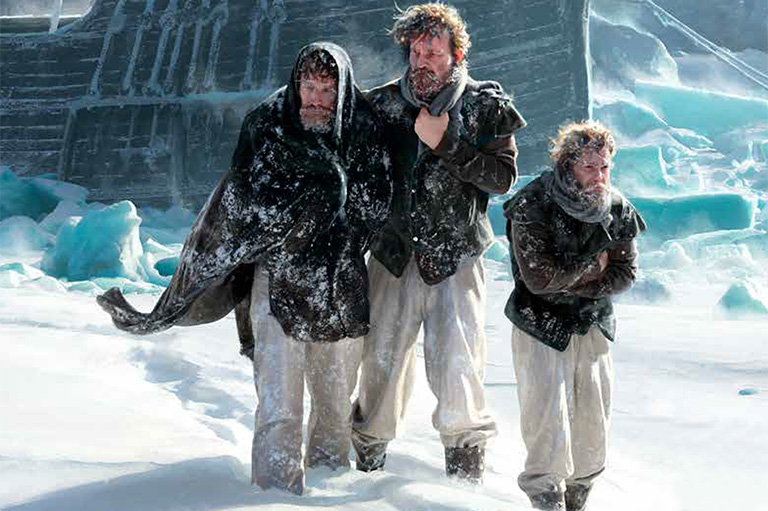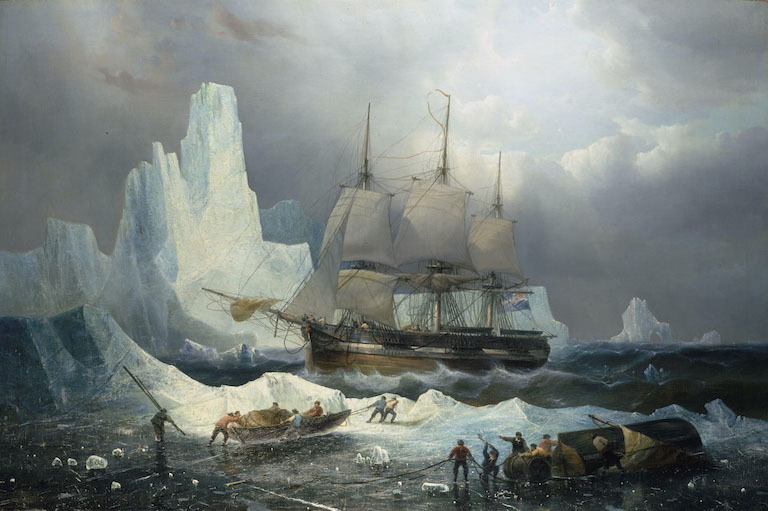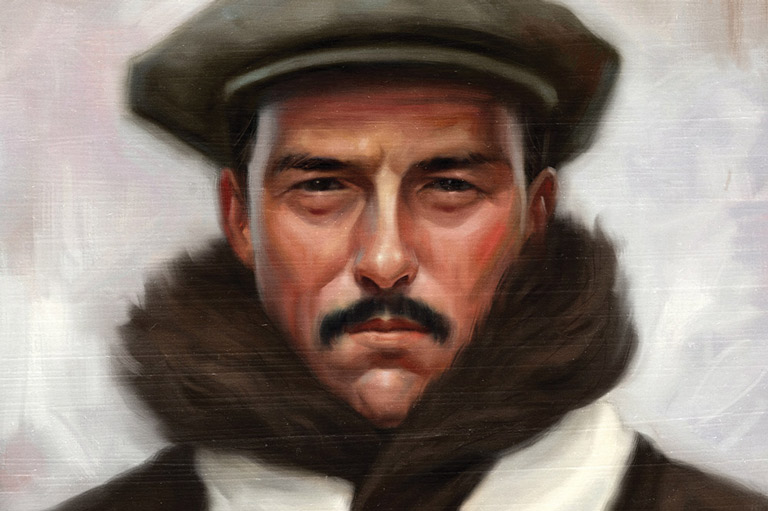Ships of Misfortune
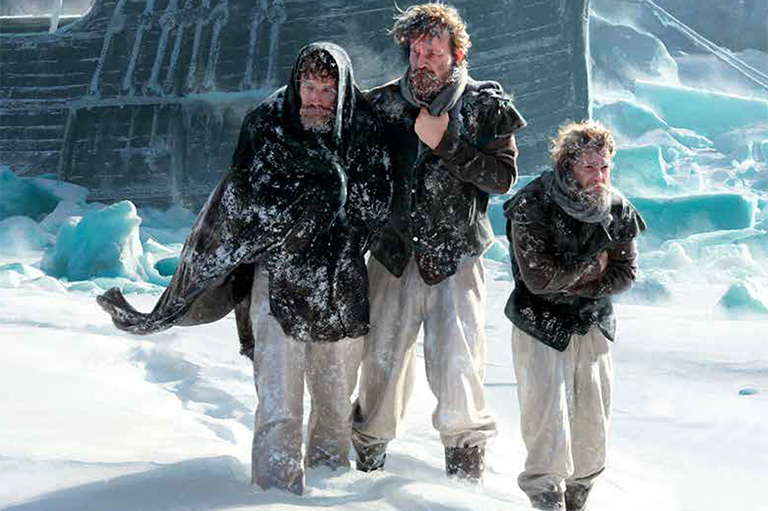
Almost a century after a catastrophe that unfolded on the Churchill River, Cree hunters told a French fur trader a strange and grisly tale. Their ancestors had stumbled upon dozens of dead bodies lying unburied on the shore, near the coast of Hudson Bay. Shocked, they had panicked and fled.
But then, collecting themselves, they cautiously returned to the site. They boarded a wrecked ship, found valuable metal items at every turn, and began a salvage so great that it lived on in oral history. Also remembered: The hunters threw apparently worthless white powder into a fire and caused a stunning explosion. The ensuing blaze destroyed a rough hut they had built.
In fur-trade country, such was the lingering memory of the disaster that befell the 1619 Jens Munk expedition. Having received the story from across generations, the Cree relayed it to the French fur trader Monsieur Jeremie when he was based in the area between 1694 and 1714. The Cree remained baffled over what had caused the deaths of those strangely dressed white men. Indeed, among history buffs, discussion continues to the present day.
But to the beginning. Jens Munk was born to Danish parents in Arendal, Norway, on June 3, 1579. His father, Erik Munk, was a tyrannical nobleman who collected unlawful taxes and made so many enemies that in 1585 he was stripped of his fiefdoms and jailed. His mother, never formally married, was evicted from the family estate with her two sons. In 1588, she sent nine-year-old Jens to live with his father’s sister and her husband in Aalborg, a flourishing Danish city of seventy thousand.
Three years later — with his disgraced father, who would later commit suicide, languishing in a dungeon — Jens Munk went to sea as a “ship’s watch” or cabin boy. Over the following thirty-one years Munk pursued a life at sea: He sailed the trade routes of the Atlantic, surviving gales, pirates, and shipwrecks. He led two ships into the Arctic Ocean north of Russia in a failed search for a Northeast Passage to China. He served as a captain in the Danish navy and triumphed in some significant battles against Sweden in 1611. In 1615, while serving under Danish Admiral Jørgen Daa, he captured the pirate Jan Mendoza after a desperate chase and hand-to-hand fighting, and he brought the outlaw back to Copenhagen for hanging.
Such were the times that, despite his distinguished service, Munk watched as nobles of vastly inferior abilities were promoted over him. Disparaged as the illegitimate son of a disgraced tyrant, Munk left the navy, recruited experienced Basque whalers, and in 1617 began whaling off the Arctic island of Spitsber gen in the Svalbard archipelago.
The whaling industry suffered a disastrous year in 1618. Having invested everything, Munk was financially ruined. Yet by early 1619 this irrepressible sailor — married now with two children — had a plan to lay before King Christian IV of Denmark and Norway. Both men had read about the recent northern voyages led by English navigators Henry Hudson and Robert Bylot and by Welsh explorer Thomas Button. Why should glorious discoveries be left to the British? Munk proposed a low-cost expedition to sail in search of the “Strait of Anian,” or the Northwest Passage — a presumed waterway that would skirt the northern coast of North America, through the icy Arctic Ocean, and thereby link the Atlantic Ocean in the east to the Pacific Ocean in the west. The king agreed to underwrite Munk’s expedition.
With 7 uniquely curated newsletters to choose from, we have something for everyone.
In May 1619, Munk left Norway with sixty-five men on two ships: the frigate Unicorn and the sloop Lamprey. On June 2, the day before he turned forty, Munk sailed past Scotland’s Shetland Islands. Late in June, after battling drifting ice, the ships reached Cape Farewell off the southern tip of Greenland. They beat across Davis Strait — which separates Greenland from Baffin Island — weaving through massive icebergs, some of them seventy metres high. This “would seem scarce credible,” Munk wrote in his journal, “to one who had not beheld it, and yet it is so in truth.” On July 8, the men sighted Baffin Island off the east coast of North America, but ice prevented them from landing.
After probing Frobisher Bay on Baffin Island, Munk sailed around Resolution Island. This small island marks the north side of the entrance into the turbulent Hudson Strait, which separates Baffin Island from the northern coast of present-day Quebec. Battling more ice, Munk proceeded along the strait’s northern coast and dropped anchor in a snug harbour. On July 19, he sent men to explore the area. That afternoon, with the ships anchored behind a small island, “we saw some people on the south side of the harbour,” Munk wrote, “so I had my boat manned as quickly as possible and went to meet them.”
In The Journal of Jens Munk 1619–1620, translated into modern English by Walter Kenyon, we read that when the Inuit hunters saw that Munk meant to land, “they hid their weapons and other implements behind some rocks and just stood waiting. When I did land, they returned my salutation, but they were careful to stay between me and the place where they had hidden their arms.”
Munk marched around the hunters, picked up their weapons, and examined them. “While I was looking them over,” he noted, the hunters “led me to believe that they would rather lose all their clothing and be forced to go naked than lose their weapons. Pointing to their mouths, they indicated that they used the weapons to procure their food.” When Munk laid the weapons aside, “they clapped their hands, looked up to heaven, and seemed overjoyed.”
Munk presented the hunters with knives and other metal goods. He gave a looking glass to one man, who did not know what it was. “When I took it from him and held it in front of his face so that he could see himself, he grabbed the glass and hid it under his clothing. After that, the natives gave me presents of everything they had, including different kinds of birds and seal meat. All the [Inuit] embraced one of my men,” he added, “who had a swarthy complexion and black hair — they thought, no doubt, that he was one of their countrymen.”
Late the next day, blocked by ice from proceeding, Munk returned to this harbour because, he wrote, “I was anxious to see more of the natives.” He wanted to consult the men about sailing conditions along the coast. But none of the Inuit hunters reappeared, not even “to fetch their fishing gear, which was lying around all the time we were there. All this suggests that they were subject to some authority which had forbidden them to visit us again.”
Munk ordered the crew to fetch water and to wash their clothes, and he sent some of his men inland to shoot “reindeer” or caribou, which were plentiful in the area. Late in the afternoon of July 22, he erected a marker bearing “the arms of His Royal Majesty King Christian IV” and, because of the excellent hunting, named the harbour Reindeer Sound. Near the fishing nets, he left a few knives and iron tools. Then he resumed sailing and ended up caught in the ice, drifting “wherever the wind and the ice might carry us, with no open water visible anywhere.”
Several times the ships were battered and damaged by ice, and at one point the men spent three days and nights working at saving the ships from being crushed. Finally, on July 31, a high tide carried them into a sheltered cove. The men collapsed, “so utterly fatigued that they could no longer endure the incredible labour of freeing the ship from the fearsome quantities of ice, likewise the extreme amount of veering and hauling which it fell to them to do.”
The next day, Munk went ashore with fifteen men, hoping to find more Inuit. They found a few tent rings and chased some deer but shot only hares. Ice conditions trapped them there for almost two weeks. On August 9, desperate to get out of the rough strait, Munk embarked and soon found himself in “so great and hollow a sea, as neither I nor any other being on board had seen before.”
Guided by two English pilots, the ships swept southwards and sailed deep into Ungava Bay — a dead end on the northeast coast of present-day Quebec. By August 20, Munk had the two ships back on course. One week later they reached the Digges Islands and entered Hudson Bay. The weather was awful, “storm and squall, snowstorm, hail and mist,” and Munk lost sight of the Lamprey.
On September 7, he spotted a low coastline to the south, where a rocky spit jutted into the sea. In a heavy storm, despite high winds, snow, hail, and fog, Munk guided the Unicorn through the rolling breakers and anchored in a safe harbour — a feat of seamanship that still dazzles experts today. Because the Lamprey was missing, Munk sent a few men ashore in a rowboat with fuel, rags, and a barrel of tar. As night fell, they created an enormous blaze on the rocks. The next day passed with no sign of the sloop. That night, the men created another fire. At daybreak they sighted the Lamprey, which arrived and entered “Jens Muncke’s Bay” — the sheltered estuary of what is today called the Churchill River.
In the exhausted new arrivals, Munk discerned the early symptoms of scurvy. As a veteran seaman, he knew how to treat this disease. “I caused the sick men to be taken ashore from the ship,” he wrote, “and there we found still some cloudberries, gooseberries, and others which in Norway are called cowberries and crowberries. And I caused thereto a good fire to be made each day for the sick, whereby they were refreshed, and thereafter came speedily to health again.”
Now came a moment worth noting. Early on the morning of September 12, after a terrible, two-day snowstorm, “a large white bear came down to the water’s edge, where it started to eat a beluga fish that I had caught the day before. I shot the bear and gave the meat to the crew with orders that it was to be just slightly boiled, then kept in vinegar overnight. I even had two or three pieces of the flesh roasted for the cabin. It was of good taste and quite agreeable.”
Munk sent men every which way to search for a superior harbour in which to winter. They found none. On September 19, after consulting with his officers, he sailed the two ships upriver as far as possible. By October 1, he had both vessels secured. Munk moved a lot of gear ashore and placed the ship’s cannons in the empty hold where they would be out of the way. To simplify cooking arrangements, he ordered all of the men to eat their meals on the Unicorn, where most of them also slept. He had the carpenters lead the men in building breakwaters.
Munk searched for anyone dwelling in these lands, but, though he discovered traces of summer encampments, he found no one. This was because the Cree who visited this area in the summer followed the animals inland as winter came on.
On October 10, Munk started rationing wine, though he let the men drink as much beer as they wished. He organized the posting of sentinels, the fetching of wood, the burning of charcoal, and the melting of snow for water. Soon men were hunting every day. They set traps, built small blinds, and ventured into open country to hunt hares, ptarmigan, and other birds. On November 15, one of the men shot “what he thought was a black fox and gleefully dragged it into the cabin, thinking he had a great prize.” Next morning, the men found it was a large dog that, judging from the hair on its muzzle, had been trained to catch game. Munk regretted not catching the dog alive, because he would “have made a peddler of him and sent him home with a packet of small gifts.”
On November 21, Munk wrote, “we buried a sailor who had been ill for a long time.” This would prove to be a harbinger of worse to come. On December 12, one of the two surgeons died: “We had to keep his body on the ship for two days because the frost was so severe that no one could get ashore to bury him.” On Christmas Eve, Munk gave the men “some wine and strong beer, which they had to boil as it was frozen.” They celebrated “the Holy Christmas Day solemnly, as is a Christian’s duty, with a goodly sermon and a mass.” Over the next few days, the men played games to amuse themselves. “At the time,” Munk wrote, “the crew was in good health and brimming with excitement.”
Advertisement
Frozen into the ice, the men found ways to endure the cold, the dark, and the blizzards. But the downward spiral intensified on January 10, 1620 — four months after Munk had shot the polar bear — when the priest and the remaining surgeon “took to their beds after having been ill for some time,” Munk wrote. “That same day my head cook perished. And then a violent illness spread among the men, growing worse each day. It was a peculiar malady, in which the sick men were usually attacked by dysentery about three weeks before they died.”
Through December and early January, healthy men continued to hunt and to provide for the rest. But by January 21 thirteen men were down with the mysterious illness, among them the sole remaining surgeon, “who was mortally ill by then.” Munk pleaded with that man “if there was not some medicine in his chest that would cure the men, or at least comfort them. He replied that he had already used every medicine he had with him, and that without God’s assistance he was helpless.”
Two days later, one of the mates died after an illness that had confined him to bed for most of the previous five months — indeed, since shortly after their arrival at the river. That same day, “the priest sat up in his berth and preached a sermon, the last one he was ever to deliver in this world.” By February 16, Munk wrote, only seven men “were healthy enough to fetch wood and water and do whatever else had to be done on board.”
In March, Munk’s journal became a litany of death. The cold became so severe that the men — now living full-time aboard the Unicorn — hesitated to go ashore even to fetch food or water. A kettle burst when the water inside it turned to ice. Occasionally, someone would contrive to shoot a few ptarmigan. Some of the men “could not eat the meat,” Munk wrote, “because their mouths were so swollen and inflamed with scurvy, but they drank the broth that was distributed amongst them.”
By late in the month, “most of the crew were so sick that they were both melancholy to listen to and miserable to behold.” Illness was raging so violently “that most of those who were still alive were too sick even to bury the dead.” Munk examined the contents of the surgeon’s chest but could make no sense of what he found: “I would also stake my life on the opinion that even the surgeon did not know how those medicines were to be used, for all the labels were written in Latin, and whenever he wished to read one, he had to call the priest to translate it for him.”
Munk went ashore, collected winter berries, and distributed them among the men. But his “greatest sorrow and misery” began as March ended. “Soon I was like a wild and lonely bird,” he wrote. “I was obliged to prepare and serve drink to the sick men myself, and to give them anything else I thought might nourish or comfort them.” By April 3, almost nobody could get out of bed, “nor did I have any men left to command, for they were all lying under the hand of God.” By now, so few were healthy “that we could scarcely muster a burial party.”
Munk wrote that he “felt abandoned by the entire world, as you may imagine.” Later in April, as the weather improved, a few men crawled out of their berths to warm themselves in the sun. “But they were so weak that many of them fainted, and we found it almost impossible to get them back into bed.” Men continued to die. The living were “so weak that we could no longer carry the dead bodies to their graves but had to drag them on the small sled that was used for hauling wood.”
Occasionally, even then, someone would shoot a grouse or a goose. But by May 10 only eleven men remained alive, all of them sick. When two more died, Munk wrote: “only God can know the torments we suffered before we got them to their graves. Those were the last bodies that we buried.” Afterwards, those who died remained unburied on the ship.
By late May, only seven men lived. Munk wrote: “We lay there day after day looking mournfully at each other, hoping that the snow would melt and that the ice would drift away. The illness that had fallen upon us was rare and extraordinary, with most peculiar symptoms.
“The limbs and joints were miserably drawn together, and there were great pains in the loins as if a thousand knives had been thrust there. At the same time the body was discoloured as when someone has a black eye, and all the limbs were powerless. The mouth, too, was in miserable condition, as all the teeth were loose, so that it was impossible to eat.”
Soon only four men remained alive on the ship, “and we just lay there unable to do a thing. Our appetites and digestions were sound, but our teeth were so loose that we could not eat.” Dead bodies lay scattered around the ship. On May 21, Munk wrote, “we had beautiful clear sunshine; and I and three others, though with great difficulty, went on shore, where we made a fire and anointed our joints with bear’s grease.” Munk returned to the ship, but two of his companions were too weak to clamber back on board. Unable to help them, he left them to their fate.
Scurvy and extreme cold afflicted not only Jens Munk and his crew but also the men of Sir John Franklin’s 1845 Arctic expedition, depicted in this 1895 painting by William T. Smith. On June 4, believing he was about to die, Munk wrote a note requesting that “if any Christians should happen to come this way, they bury my poor body in the earth, together with the others that are lying here.” He asked that his journal be sent to his “most gracious Lord and King … in order that my poor wife and children may obtain some benefit from my great distress and miserable death.”
Five days later, having crawled out on deck and spent a night “wrapped in the clothing of those who were already dead,” Munk was astonished to see the two crewmen whom he had left behind in May walking around on land. Munk had assumed they were dead. But now they crossed the ice to the ship and helped him ashore. Together, they sheltered “under a bush on shore, where we built a fire each day.”
Whenever they found “any green thing” growing, they would dig it up and suck the juice out of its main root. The weather grew warmer, and, slowly, the three began to regain their strength. They reboarded the Unicorn and found nobody living. They retrieved a gun and returned to shore, where they shot and ate birds. From the Lamprey they took a flounder net that enabled them to catch trout.
Slowly, the three survivors recovered. From the Unicorn, they threw decomposing bodies overboard, “because the smell was so bad that we couldn’t stand it.” Then, battling a plague of blackflies, and as ice began clearing from the bay, they stocked the smaller Lamprey with enough food to reach home. Finally, on July 16, 1620, Munk wrote, “we set sail, in the name of God, from our harbour.”
Such was Munk’s navigational skill that he guided the sloop through fog, ice, gale-force winds, and the swirling currents of Hudson Strait, and then across the storm-tossed Atlantic Ocean. On September 22, Munk reached Norway, and “our joy was so great we could not hold back our tears.”
Save as much as 40% off the cover price! 4 issues per year as low as $29.95. Available in print and digital. Tariff-exempt!
Of the sixty-five men who had sailed from Norway, only three survived. Most accounts blame the devastation solely on scurvy. But, while that scourge was almost certainly a contributing factor, an article by Delbert Young, published five decades ago in the Winter 1973 edition of The Beaver magazine (now Canada’s History), suggested that the root cause was something else. In an article headlined “Was There An Unsuspected Killer Aboard ‘The Unicorn,’” Young wrote: “Possibly the crew died, as historians have claimed, from cold, privation, and the scurvy.” But, he added, “this too-simple explanation is difficult to accept.”
During his three-decades-long sailing career, Young noted, Munk had learned how to treat scurvy, a disease caused by severe vitamin C deficiency. The two English navigators on board the Unicorn also knew how to stave off the disease by boiling the needles and gum of evergreens and drinking the resulting broth.
Furthermore, Munk was familiar with the symptoms of scurvy: anemia, bleeding gums, bruising, and poor wound healing. Yet Munk wrote that his sailors were suffering from a “peculiar malady” that included violent attacks of dysentery — not a primary symptom of scurvy.
Given these clues, and the fact that the sailors had shot and eaten at least one polar bear, Young theorized that Munk’s crew was suffering from the parasitical disease trichinosis, caused by a type of roundworm known as trichinella. The disease remained unidentified until the twentieth century.
Trichinosis, Young explained, is “next to being endemic” in polar bears. When a person eats infected, undercooked meat, trichinella larvae are deposited in that person’s stomach. The tiny parasites then embed themselves in the intestines, where they grow into adult worms. After the adult worms reproduce, the new larvae enter the bloodstream and, within weeks, encyst themselves in muscle tissue throughout the body. Abdominal symptoms, including diarrhea, abdominal pain, nausea, and vomiting, can occur one or two days after infection. Other symptoms usually start two to eight weeks after infection, as larvae enter the bloodstream and burrow into muscle tissue. These symptoms include high fever, muscle pain and tenderness, weakness, headaches, and sensitivity to light. In severe cases, the larvae “can migrate to vital organs, causing potentially dangerous, even fatal, complications,” Young wrote. Left untreated, trichinosis can culminate in death as early as four to six weeks after ingestion, or months later. A description published by the Mayo Clinic confirms this pathology.
Recalling that, after shooting the polar bear, Munk had told his cook to “just slightly boil” the meat before putting it in vinegar, and that only “two or three pieces of the meat” were “roasted for the cabin,” Young asked whether, “at the very least, the first men to die may have met their deaths from eating the bear meat.”
Munk never identified the men who sat at his table in the cabin and therefore ate roasted — as opposed to under-cooked — bear meat. Probably Munk’s table would have included some of the ships’ mates, all of whom died. But one wonders whether the two men who survived — those who went ashore with Munk on May 21 — might also have been among those at his table who ate the roasted bear meat. If those two were suffering from scurvy only, then they might have cleared the symptoms with the fresh root vegetables — and the same is true of Munk.
Museum curator Peter A. Toft, who recently wrote a book chapter about seventeenth-century Danish expeditions to the Arctic, notes that Young’s theory on trichinosis “has not been cited in Danish publications on the expedition, where scurvy is generally described as the cause for the death of the majority of the crew.” Toft argues that, from Munk’s “single description of the disease as rare and extraordinary, it is not very clear whether he questions the sickness to be scurvy or is surprised by the extent and severity of a scurvy attack, that he may not have experienced previously. I don’t think we will ever know for sure whether scurvy or trichinosis killed the crew — or potentially both.”
David Waltner-Toews, one of Canada’s leading epidemiologists, explains that “a lot of diseases can kill a person if they are already weak or co-infected, so pinpointing one cause in the Munk outbreak is a challenge.” A professor emeritus at the University of Guelph, Waltner-Toews is the author of numerous books across several genres and has published approximately one hundred peer-reviewed scholarly papers, as well as a textbook about the natural history of diseases transmitted from animals to people. Regarding Delbert Young’s suggestion that trichinosis was a root cause of the sweeping destruction of Munk’s expedition — a situation complicated by cold and scurvy — Waltner-Toews opined that this “version of events is as reasonable as any, and more reasonable than most.”
And what of the on-location aftermath of Munk’s expedition? According to the French fur trader Monsieur Jeremie, the Cree probably knew nothing of the catastrophe until the spring of 1621, by which time the ice had thoroughly wrecked the Unicorn. Writing seven to nine decades later, Jeremie noted that, after the Cree recovered from the sight of the dead bodies, they broke up the cylinder head of a cast-iron cannon, learned by accident that gunpowder could be extraordinarily destructive, and carried off everything worth saving. Those Cree who later visited the site found nothing of value but nails. Among them, only the stories endured.
We hope you will help us continue to share fascinating stories about Canada’s past.
We highlight our nation’s diverse past by telling stories that illuminate the people, places, and events that unite us as Canadians, and by making those stories accessible to everyone through our free online content.
Canada’s History is a registered charity that depends on contributions from readers like you to share inspiring and informative stories with students and citizens of all ages — award-winning stories written by Canada’s top historians, authors, journalists, and history enthusiasts.
Any amount helps, or better yet, start a monthly donation today. Your support makes all the difference. Thank you!
Themes associated with this article
Advertisement

